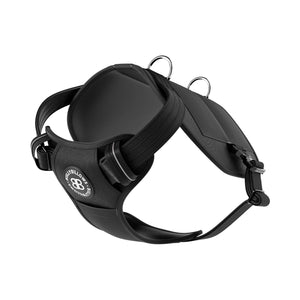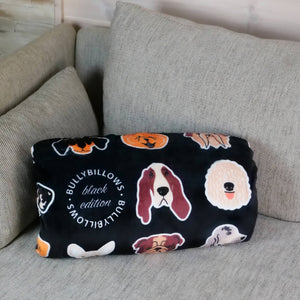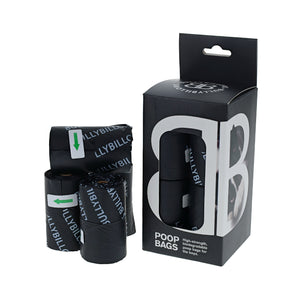Having a dog is the best thing in the world. There’s nothing quite like having a cute companion ready to greet you every morning and join you on every adventure you want to go on.
However, the struggle with fur malting can be real, especially when it comes to longer-haired dog breeds. That’s why, as a pet owner, learning how to stop dog shedding is just part and parcel of being a doting pooch parent.
You’ll know that far too often, you leave the house looking like you’ve rolled around in your dog’s bed when in actual fact, you put in a good shift with the lint roller.
That’s not even to mention your furniture, which always seems to have a layer of fur on it you just can’t seem to shift.
Understanding how to reduce dog shedding is also crucial for managing fur allergies. The last thing you want is for your visitors to leave with red eyes and a runny nose every time they come round for a cuppa.
So, keep reading for our top tips on how to control dog shedding and handy product recommendations…
Why do dogs shed their fur?
Before we explore some of the best ways you can prevent dogs shedding, let’s take a quick look at why it happens and some of the factors that affect it most.
Natural hair growth cycle
Just like their owners, dogs also have a biological hair growth cycle. The three scientific stages of a dog’s hair growth cycle are:
- Anagen - when the hairs are actively growing.
- Catagen - when the hairs stop growing and the follicle shrinks.
- Telogen - when the hairs fall out (shed) and new hairs prepare to grow.
So, the pesky dog hairs you find all over your clothes and furniture are probably ones that have dropped out during the telogen hair cycle phase.
Breed (or mix of breeds)
The breed of your dog will dictate how much they will or won’t shed their fur. Huskies, German Shepherds, Golden Retrievers, and Corgis, for example, are all notorious double-coated breeds known for shedding way more than their single-coated counterparts.

Dogs with straight fur are also renowned for shedding significantly more than breeds with curly or wiry coats like Poodles or Maltese.
Things can get a bit more complicated where mixed breeds are concerned as you get a cocktail of genetics coming into play.
Labradoodles, for example, are championed as a low-shedding, hypoallergenic breed but sometimes, it’s more the case of dropped hairs being caught and trapped in the curly coat. That’s why this breed (and others similar) is at higher risk of matting and requires more meticulous grooming.
Seasonal shedding
Some breeds have more than one type of coat so they can (cleverly) switch it up between seasons.
So, depending on the temperatures or the time of year, some dogs will shed one coat for another—they’ll malt out of their lighter spring/summer coat ready for a thicker, autumn/warmer winter coat to come through, for example.
Age
As a dog ages, the hair growth cycle becomes quicker, which means shedding happens more often In fact, senior pooches are shown to shed up to 20% more than younger pups.
Diet and hydration levels
If the condition of your dog’s skin or coat isn’t great, you’ll notice they malt far more. Diet, nutrition, and hydration levels are huge contributing factors when it comes to the condition of your dog’s fur and the skin underneath.
If your four-legged friend isn’t drinking enough or not getting the right nutrients, the internal effects can manifest through their fur falling out.
So, one of the best ways to prevent shedding is to keep your pet as healthy and hydrated as possible—but more on this further on.
Health conditions
Some shedding is normal and the amount will fluctuate depending on things like the breed and age of the dog, as well as the time of year or temperature outside. However, shedding—particularly excessive hair loss—could also indicate an underlying health concern.
Hair loss in dogs can be linked to things like:
- Fungal and bacterial infections
- Kidney problems
- Hormonal issues
- Liver problem
- Pregnancy
- Sunburn
- Hypothyroidism
- Autoimmune issues
- Cushing’s disease
Excessive shedding can also be a side effect of some medications, so it’s worth checking this out if your dog is currently being treated for anything.
If you are worried about how much your dog is losing fur and there’s no obvious reason why, book an appointment with your vet to discuss your concerns.
Stress levels and overall mood
Just like humans, if a dog is overly anxious or stressed, this can lead to their hair falling out more than normal.
This can be down to their natural temperament but it can also be influenced by stressful things like moving house, introducing them to a new puppy, or bad discipline techniques.
Take measures to keep your pooch calm and chilled out to prevent unnecessary fur shedding.
Effective ways to stop a dog shedding
Shedding a typical amount of hair is normal for every dog—it’s just part of the natural makeup of the species and can’t be prevented entirely.
However, there are steps you can take to reduce dog shedding to help keep your home and clothes fur-free and to alleviate allergic reactions as much as possible.
So, if you’ve been wondering how you can control dog shedding more effectively, keep on scrolling.
Regular and thorough grooming
A regular and thorough grooming routine is one of the best ways to stop a dog shedding excessive fur. This includes regular trips to the doggy salon for professional grooming as well as day-to-day TLC at home.
Taking your fur baby to a professional groomer will ensure their coat is being treated with the right tools and products for their breed and hair type. Long-haired breeds will require different types of brushes to short-haired breeds, for instance, to help combat tangles and matting.
Qualified dog groomers can also do things like blast out undercoats with purpose-built dryers to prevent the shedding of seasonal coats from being prolonged.
Invest in some tools to stop dog shedding
Routine trips to the groomer are essential but so is at-home maintenance too. Make sure you’re equipped with the right dog brush for your pup’s coat to help keep their skin and hair in great condition between salon visits.
We also recommend buying a Deshedding Blade Set, which is specifically designed to reduce dog hair shedding—and it is a lot less scary than it sounds, we promise!
We even stock cute Pink Deshedding Blades too if you fancy something more colourful.
Feed your dog a healthy, balanced diet
As we covered earlier, the diet your dog eats will have a huge impact on the condition of their skin and coat, which will also affect how much they shed hair.
For example, hair is mostly made up of proteins, which means your dog needs an adequate amount of protein in their diet to maintain a healthy coat.

They also need a broad range of other vitamins and minerals to keep them healthy from the inside out and this can be achieved with a healthy, low-fat diet.
Make sure your pet is getting plenty of the following nutrients to maintain healthy skin and coat—and if not, consider supplementing any deficiencies (after seeking advice from your vet):
- Omega-3 and Omega-6
- Biotin
- Zinc
- Vitamin E
- Vitamin B5
- Vitamin B3
If you think your dog might require a special type of diet, speak to your vet about that too and they’ll be able to steer you and your fur baby in the right direction.
Keep your pooch well-hydrated
As well as getting all the right vitamins, minerals, and nutrients, your dog also needs to stay hydrated. If they don’t drink enough water, their skin and coat will become dried out, which leads to more shedding than usual.
General guidelines say that dogs should be drinking between 50ml and 100ml of water per kg of body weight per day. Keep multiple clean, fresh water bowls around the house to encourage your pooch not to get parched.

Get your top-quality Dog Shedding Blades right here at BullyBillows
We hope you’ve found our tips on how to stop a dog shedding helpful. Hopefully we’ve also managed to save you some money on buying lint rollers to keep your clothes and furniture fur-free too!
While you’re here, don’t forget to check out our full range of dog accessories and dog walking essentials. From our luxury human dog walking bag to engraved dog ID tags that are now required by law, we’ve got you and your four-legged friend well covered.
For more news, advice and product buying guides check out the rest of our blog…
Dog & Puppy Dental Care Guide | Dog Grooming and Care Guide | How To Muzzle Train A Dog








































































